Choosing and installing a water heater under the sink:
In this article we will tell you about the criteria according to which criteria a water heater is selected to give with a sink. We will also consider what types of water heaters are on the market, and what from this range it is advisable to purchase.
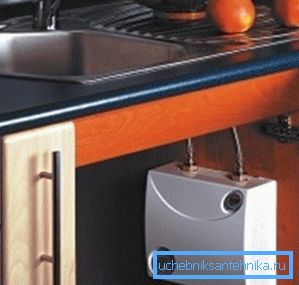
General information
The topic of the article is relevant, since most of the suburban construction sites are not connected to a centralized hot water supply. Again, autonomous heating systems often do not imply the possibility of heating water for a kitchen sink and a washbasin in a bathroom.
Meanwhile, warm water in the faucet is an essential condition of life comfort. The problem of the lack of warm water is easy to solve, it is enough to install a water heater under the sink for 10 liters. There is a wide range of such equipment on the market, it remains to determine what to choose.
Main varieties
In accordance with the principle of operation, all water heaters can be divided into two main types, namely:
- Devices with accumulative capacity - this is the most demanded type of equipment, which is characterized by economical energy consumption and ease of operation. Compact storage boilers with compact dimensions run on electricity, which guarantees additional convenience during their installation.
- Flow Heater Devices - less common due to higher energy consumption. In addition, the price of such units is much higher than the cost of analogues with a cumulative capacity.
Such units in accordance with the type of fuel consumed can be of two types: electric and gas (column).
Geysers can be used only in those houses that are connected to the gas distribution pipeline. When deciding to purchase an electric heater, you need to make sure that the condition of the house wiring allows you to operate the equipment with a power consumption of more than 2 kW / hour.
Important: The compact flow heater can not cope with its task with excessively strong water pressure.
Design features of boilers
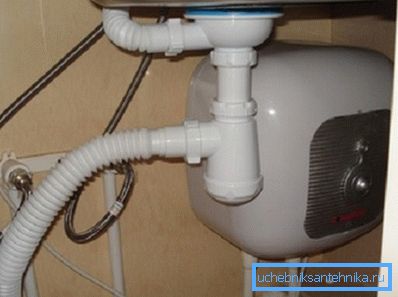
Storage water heaters of 10 liters under the sink are a closed structure consisting of the following elements:
- The outer casing (housing), as a rule, is made of thin sheet steel with an enamel coating. Less often the case is made of polished aluminum.
The design of the housing has little effect on the operational features of the heater. The choice of configuration mainly depends on the convenience of the equipment in a limited space and on aesthetic preferences.
- Thermal insulation layer, in which quality, most often, rigid polyurethane foam is used, less often foam rubber. The type of heat-insulating layer used determines the time during which the heated water will keep the set temperature.
- Accumulative capacity - represents a tight metal tank. Domestic manufacturers produce stainless steel storage tanks, while in Western European countries, preference is given to the production of steel tanks with enamel, ceramic or glass coating.
- The inlet intended for cold water supply is made of brass and is a tube with an external thread.
- The outlet pipe for using warm water is not much different from the inlet pipe. For ease of use, this structural element is equipped with stop valves, which allows you to shut off the water supply from the tank;
- Heater is responsible for heating water to the desired temperature. Heaters can be either dry or wet.
A wet heater is in contact with water and therefore a layer of scale builds up on it. Dry PETN does not come into direct contact with water, as it is enclosed in a metal tube with an enamel coating. Therefore, on the heating element scaling is not delayed, and it serves twice as much as a conventional heater.
- Magnesium ("sacrificial") anode is a metal rod that rusts instead of the heating elements or tank. On average, the anode serves for 5 years until complete destruction. After this, the anode must be replaced.
- The temperature sensor is located in the tank in a special sealed tube. The main objective of this device is to turn off the heater after the water temperature reaches a certain limit.
Despite the seeming complexity of the boiler, operation is extremely simple and completely safe.
Flow Heater Design
The choice of a flow boiler for installation under the sink is more preferable than the purchase of a storage unit with a massive tank of 30 liters. Despite the absence of a storage tank, the design of the flow-through boiler is more complex.
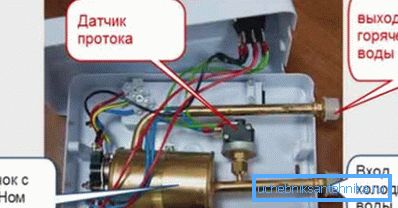
The scheme of the majority of units of this type on the market includes the following elements:
- Protective case - can be made of metal or of temperature resistant plastic. The case is compact and equipped with everything necessary for installation in a confined space.
- Heating element - electric heating element, which, depending on the modification of the device, may be one or several. The parameters of the heating element largely determine the performance of the device and power consumption.
- Flow sensor - This device, which includes a heating element, if the water supply is carried out with sufficient pressure. Thus, if the pressure is weak, the circuit will not work and the heating element will not burn.
- Power supply relay works in a pair of duct sensor. It is through these relays that the power supply of the heating element is switched on.
- Temperature sensor it is intended for control of temperature of TENA and for prevention of its overheat.
Important: Boilers flow and accumulative type necessarily grounded, it is necessary for the effective discharge of static electricity.
Features of the installation work
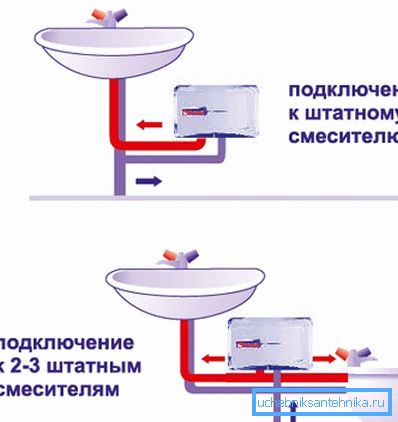
After we have considered the structural features of water heaters, we will determine what instruction to install them under the sink.
Most often, a compact heater is mounted under the kitchen sink, as warm water is sometimes necessary for washing dishes.
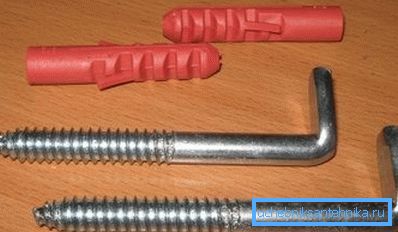
Flow type heaters are less complex to install compared to cumulative counterparts. Due to the absence of a tank and low weight, the flow-through boiler can be fixed by hand on one of the walls of the washing cabinet.
In the case of the device, as a rule, there are special grooves for the brackets, which, in turn, are mounted on the screws. On the case of the device there are two connections. A hose with water supply is attached to the incoming pipe, and a hose to the mixer is connected to the pipe at the outlet.
Once again, we can only connect the heater to a grounded outlet. If the wiring in the house is not grounded, you need to take care of the independent device circuit.
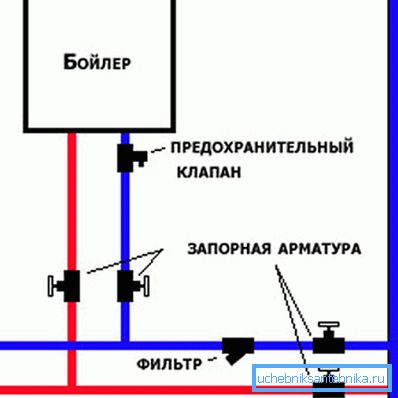
Installing a cumulative boiler for 15 liters is not much different from the instructions given, except that the installation is carried out not on the wall of the washing pedestal, but on a regular wall that will withstand the load of the cumulative tank filled with water.
Conclusion
Now that we know what a compact water heater is, we can choose the best option for installing under the sink (see also the article Why a storage water heater is needed under the sink in the kitchen).
Have any questions? Exhaustive answers can be found by watching the video in this article.